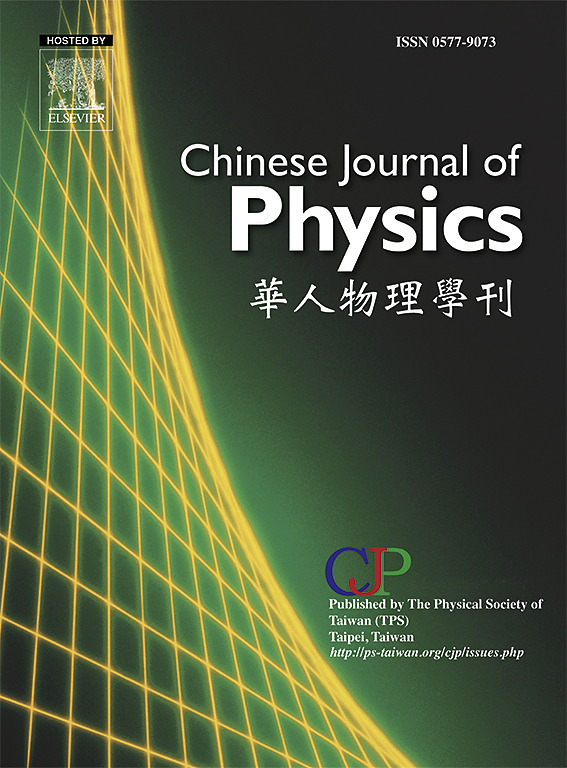The modulation of the electronic properties of MoSi2N4/CdS heterostructure by interlayer spacing, strain, and electric field: A first-principles investigations
IF 4.6
2区 物理与天体物理
Q1 PHYSICS, MULTIDISCIPLINARY
引用次数: 0
Abstract
In this work, the variation in the electronic properties of the MoSi2N4/CdS heterostructure with interlayer spacing, strain, and external electric field are investigated using first-principles methods. The MoSi2N4/CdS heterostructure is an indirect bandgap semiconductor with a band gap of 1.31 eV, work function of 5.45 eV, and Type II band edge alignment. As the interlayer spacing decreases, when DZ-D (the difference between the actual interlayer spacing DZ and the equilibrium spacing D = 3.2 Å) is -0.5 Å, the band gap increases to a maximum value of 1.55 eV. Then, the band gap gradually decreases to 0 eV at DZ-D = -1.5 Å. When the compressive strain increases, the band gap increases to a maximum value of 1.93 eV at a stress of -4%, then gradually decreases to 1.28 eV. When an external electric field is applied, the band gap decreases to 0.68 eV with an increased positive electric field (MoSi2N4 layer pointing perpendicularly to the CdS layer). However, with a negative electric field, the band gap increases to the maximum value of 1.7 eV at the electric field strength of -0.3 V/Å, gradually decreasing to 0 eV. Based on the electron density difference, the density of state, projected band structure, mechanisms of band gap changes, and band edge alignment variations are analyzed. This paper found that by adjusting the interlayer spacing, applying planar biaxial strain, and applying external electric fields, the band gap and heterostructure type of the MoSi2N4/CdS heterostructure can be effectively tuned, providing theoretical references and new options for applications such as flexible electronic devices and wearable technology.

层间距、应变和电场对MoSi2N4/CdS异质结构电子特性的调制:第一性原理研究
本文采用第一性原理方法研究了MoSi2N4/CdS异质结构的电子性能随层间距、应变和外加电场的变化规律。MoSi2N4/CdS异质结构为间接带隙半导体,带隙为1.31 eV,功函数为5.45 eV,带边取向为II型。随着层间距的减小,当DZ-D(实际层间距DZ与平衡间距D = 3.2 Å之差)为-0.5 Å时,带隙增大到最大值1.55 eV。然后,在DZ-D = -1.5 Å处,带隙逐渐减小至0 eV。当压缩应变增大时,带隙在应力为-4%时达到最大值1.93 eV,之后逐渐减小至1.28 eV。外加电场时,带隙减小到0.68 eV,正电场增大(MoSi2N4层垂直指向CdS层)。而在负电场条件下,电场强度为-0.3 V/Å时,带隙增大到最大值1.7 eV,逐渐减小到0 eV。基于电子密度差,分析了态密度、投影带结构、带隙变化机制和带边对准变化。研究发现,通过调整层间距、施加平面双轴应变和外加电场,可以有效调节MoSi2N4/CdS异质结构的带隙和异质结构类型,为柔性电子器件和可穿戴技术等应用提供理论参考和新的选择。
本文章由计算机程序翻译,如有差异,请以英文原文为准。
求助全文
约1分钟内获得全文
求助全文
来源期刊

Chinese Journal of Physics
物理-物理:综合
CiteScore
8.50
自引率
10.00%
发文量
361
审稿时长
44 days
期刊介绍:
The Chinese Journal of Physics publishes important advances in various branches in physics, including statistical and biophysical physics, condensed matter physics, atomic/molecular physics, optics, particle physics and nuclear physics.
The editors welcome manuscripts on:
-General Physics: Statistical and Quantum Mechanics, etc.-
Gravitation and Astrophysics-
Elementary Particles and Fields-
Nuclear Physics-
Atomic, Molecular, and Optical Physics-
Quantum Information and Quantum Computation-
Fluid Dynamics, Nonlinear Dynamics, Chaos, and Complex Networks-
Plasma and Beam Physics-
Condensed Matter: Structure, etc.-
Condensed Matter: Electronic Properties, etc.-
Polymer, Soft Matter, Biological, and Interdisciplinary Physics.
CJP publishes regular research papers, feature articles and review papers.
 求助内容:
求助内容: 应助结果提醒方式:
应助结果提醒方式:


